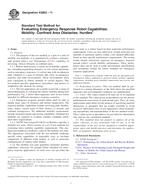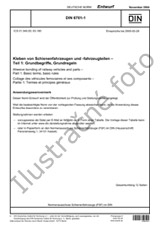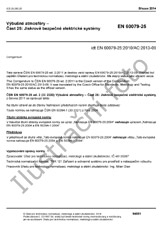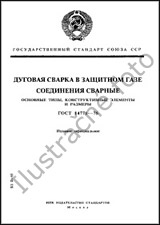Potrebujeme váš súhlas na využitie jednotlivých dát, aby sa vám okrem iného mohli ukazovať informácie týkajúce sa vašich záujmov. Súhlas udelíte kliknutím na tlačidlo „OK“.
ASTM E2802-11
Standard Test Method for Evaluating Emergency Response Robot Capabilities: Mobility: Confined Area Obstacles: Hurdles
Automaticky preložený názov:
Štandardná skúšobná metóda pre hodnotenie Emergency Response Robot schopností: Mobilita: stiesnenom priestore Prekážky: Prekážky
NORMA vydaná dňa 1.7.2011
Informácie o norme:
Označenie normy: ASTM E2802-11
Poznámka: NEPLATNÁ
Dátum vydania normy: 1.7.2011
Kód tovaru: NS-46065
Počet strán: 10
Približná hmotnosť: 30 g (0.07 libier)
Krajina: Americká technická norma
Kategória: Technické normy ASTM
Kategórie - podobné normy:
Anotácia textu normy ASTM E2802-11 :
Keywords:
abstain, emergency response, emergency responder, flat-floor terrain element, human-scale, mobility, OCU, operator control unit, operator station, oriented strand board, OSB, repetition, robot, test suite, urban search and rescue, US&R, ICS Number Code 13.200 (Accident and disaster control), 25.040.30 (Industrial robots. Manipulators)
Doplňujúce informácie
| Significance and Use | ||||||
|
A main purpose of using robots in emergency response operations is to enhance the safety and effectiveness of emergency responders operating in hazardous or inaccessible environments. The testing results of the candidate robot shall describe, in a statistically significant way, how reliably the robot is able to negotiate the specified types of obstacles and thus provide emergency responders sufficiently high levels of confidence to determine the applicability of the robot. This test method addresses robot performance requirements expressed by emergency responders and representatives from other interested organizations. The performance data captured within this test method are indicative of the testing robot’s capabilities. Having available a roster of successfully tested robots with associated performance data to guide procurement and deployment decisions for emergency responders is consistent with the guideline of “Governments at all levels have a responsibility to develop detailed, robust, all-hazards response plans” as stated in National Response Framework. This test apparatus is scalable to constrain robot maneuverability during task performance for a range of robot sizes in confined areas associated with emergency response operations. Variants of the apparatus provide minimum lateral clearance of 2.4 m (8 ft) for robots expected to operate around environments such as cluttered city streets, parking lots, and building lobbies; minimum lateral clearance of 1.2 m (4 ft) for robots expected to operate in and around environments such as large buildings, stairwells, and urban sidewalks; minimum lateral clearance of 0.6 m (2 ft) for robots expected to operate within environments such as dwellings and workspaces, buses and airplanes, and semi-collapsed structures; minimum lateral clearance of less than 0.6 m (2 ft) with a minimum vertical clearance adjustable from 0.6 m (2 ft) to 10 cm (4 in.) for robots expected to deploy through breeches and operate within sub-human size confined spaces voids in collapsed structures. The standard apparatus is specified to be easily fabricated to facilitate self-evaluation by robot developers and provide practice tasks for emergency responders that exercise robot actuators, sensors, and operator interfaces. The standard apparatus can also be used to support operator training and establish operator proficiency. 5.5 Although the test method was developed first for emergency response robots, it may be applicable to other operational domains. |
||||||
| 1. Scope | ||||||
|
1.1 Purpose: 1.1.1 The purpose of this test method, as a part of a suite of mobility test methods, is to quantitatively evaluate a teleoperated ground robot’s (see Terminology E2521) capability of traversing vertical obstacles in confined areas. 1.1.2 Robots shall possess a certain set of mobility capabilities, including negotiating obstacles, to suit critical operations such as emergency responses. A vertical step with an unknown edge condition is a type of obstacle that exists in emergency response and other environments. These environments often pose constraints to robotic mobility to various degrees. This test method specifies apparatuses, procedures, and metrics to standardize this obstacle for testing. 1.1.3 The test apparatuses are scalable to provide a range of lateral dimensions to constrain the robotic mobility during task performance. Fig. 1 shows three apparatus sizes to test robots intended for different emergency response scenarios. 1.1.4 Emergency response ground robots shall be able to handle many types of obstacles and terrain complexities. The required mobility capabilities include traversing gaps, hurdles, stairs, slopes, various types of floor surfaces or terrains, and confined passageways. Yet additional mobility requirements include sustained speeds and towing capabilities. Standard test methods are required to evaluate whether candidate robots meet these requirements. 1.1.5 ASTM Task Group E54.08.01 on Robotics specifies a mobility test suite, which consists of a set of test methods for evaluating these mobility capability requirements. This confined area hurdle test method is a part of the mobility test suite. The apparatuses associated with the test methods challenge specific robot capabilities in repeatable ways to facilitate comparison of different robot models as well as particular configurations of similar robot models. 1.1.6 The mobility test suite quantifies elemental mobility capabilities necessary for ground robots intended for emergency response applications. As such, users can use either the entire suite or a subset based on their particular performance requirements. Users are also allowed to weight particular test methods or particular metrics within a test method differently based on their specific performance requirements. The testing results should collectively represent an emergency response ground robot’s overall mobility performance. These performance data can be used to guide procurement specifications and acceptance testing for robots intended for emergency response applications. Note 1—Additional test methods within the suite are anticipated to be developed to address additional or advanced robotic mobility capability requirements, including newly identified requirements and even for new application domains. 1.2 Performing Location—This test method shall be performed in a testing laboratory or the field where the specified apparatus and environmental conditions are implemented. 1.3 Units—The values stated in SI units are to be regarded as the standard. The values given in parentheses are not precise mathematical conversions to inch-pound units. They are close approximate equivalents for the purpose of specifying material dimensions or quantities that are readily available to avoid excessive fabrication costs of test apparatuses while maintaining repeatability and reproducibility of the test method results. These values given in parentheses are provided for information only and are not considered standard. 1.4 This standard does not purport to address all of the safety concerns, if any, associated with its use. It is the responsibility of the user of this standard to establish appropriate safety and health practices and determine the applicability of regulatory limitations prior to use.
|
||||||
| 2. Referenced Documents | ||||||
|
Podobné normy:
1.3.2013
NEPLATNÁ
1.1.2011
NEPLATNÁ
1.11.2010
1.1.2002
1.1.1983
1.1.1983
Odporúčame:
Aktualizácia technických noriem
Chcete mať istotu, že používate len platné technické normy?
Ponúkame Vám riešenie, ktoré Vám zaistí mesačný prehľad o aktuálnosti noriem, ktoré používate.
Chcete vedieť viac informácií ? Pozrite sa na túto stránku.



 DIN ISO 29262:2013-0..
DIN ISO 29262:2013-0.. E DIN EN ISO 13482:2..
E DIN EN ISO 13482:2.. GOST 12.2.072-98..
GOST 12.2.072-98..
 Cookies
Cookies
